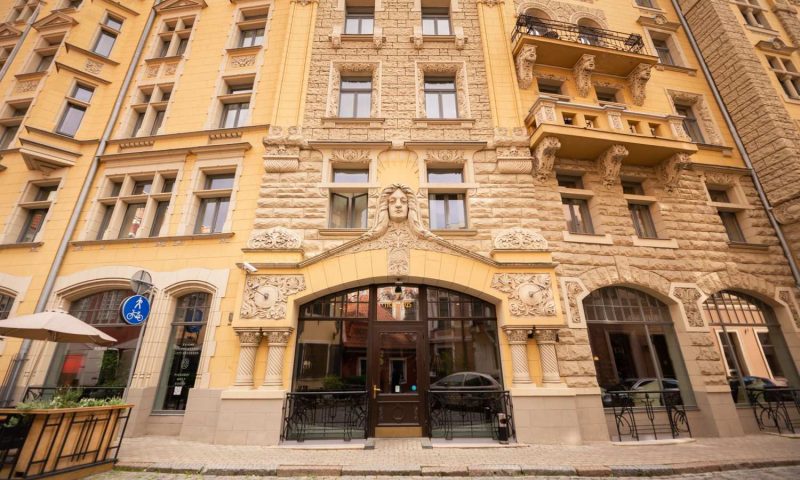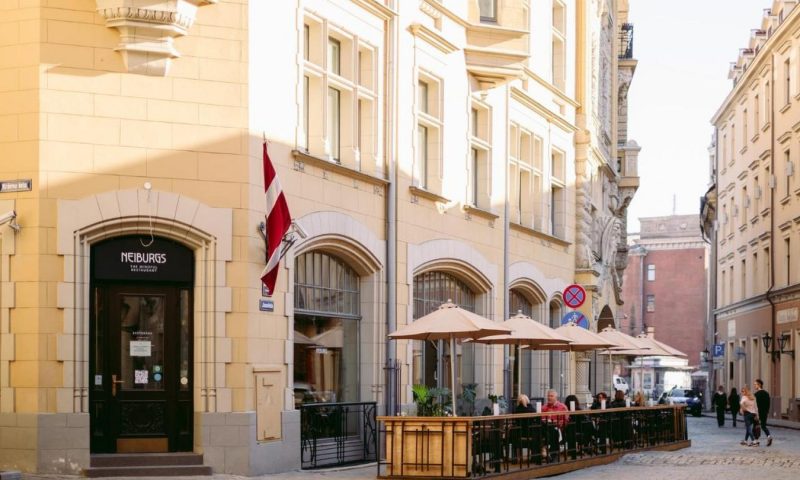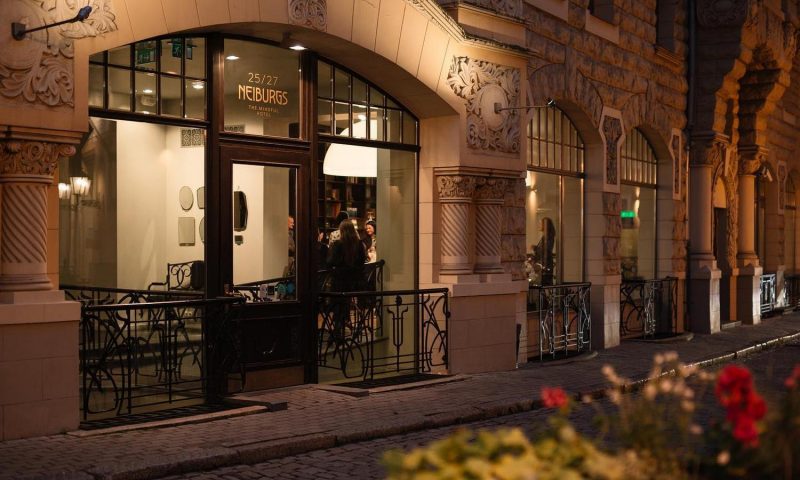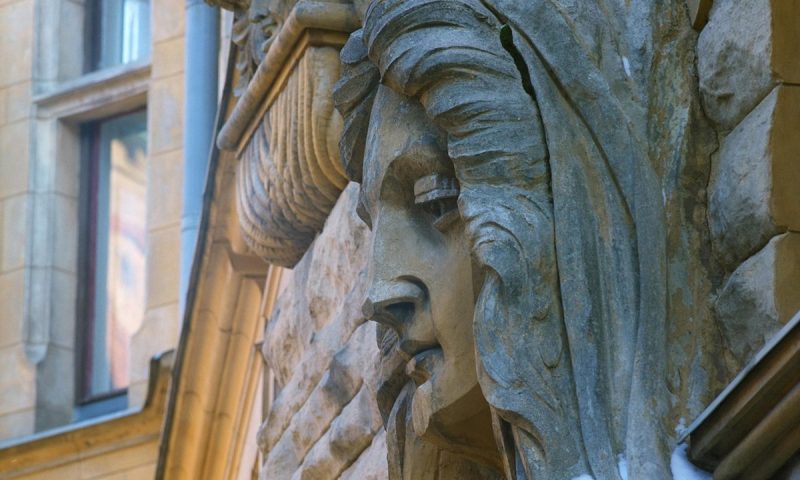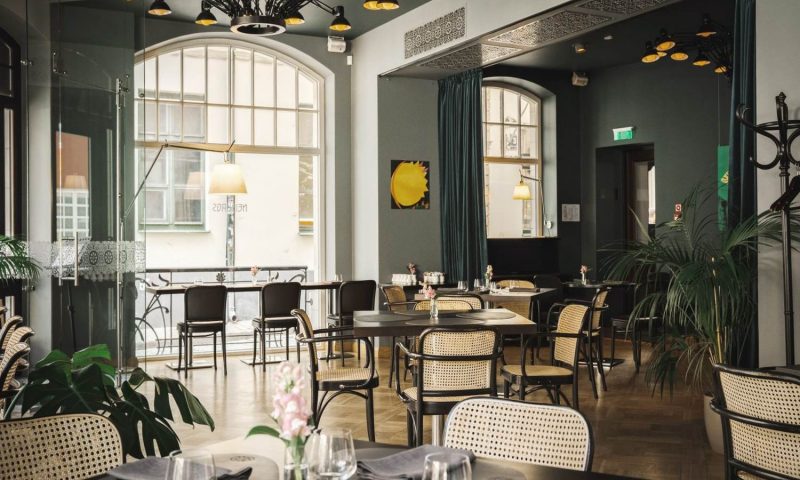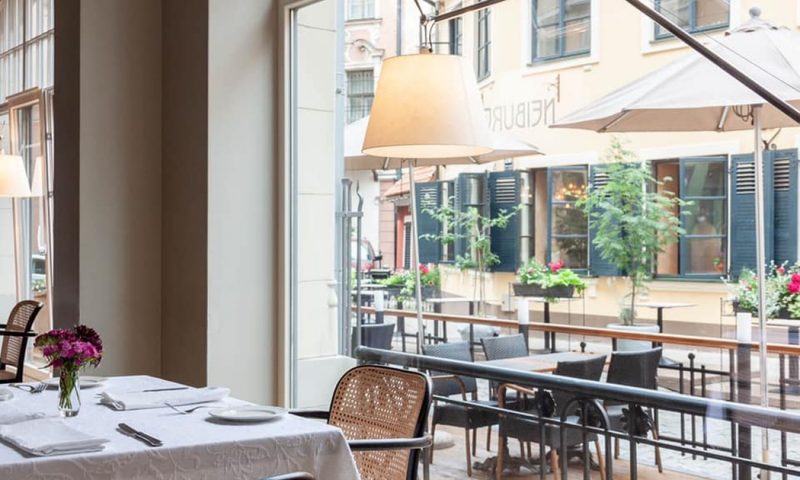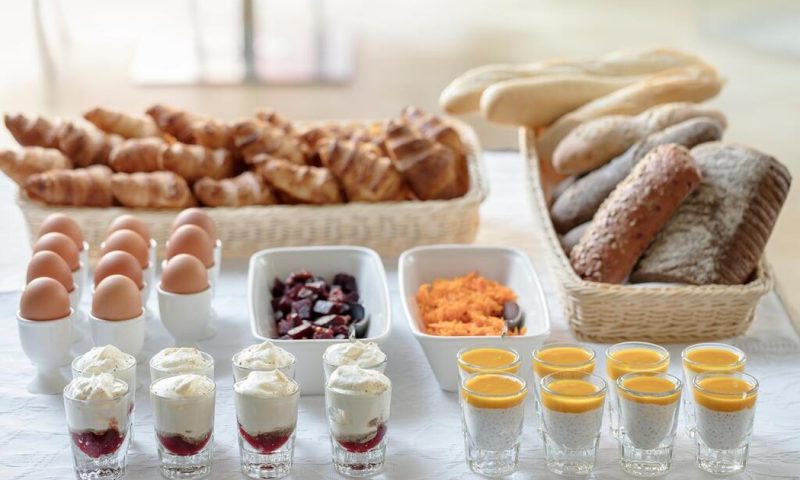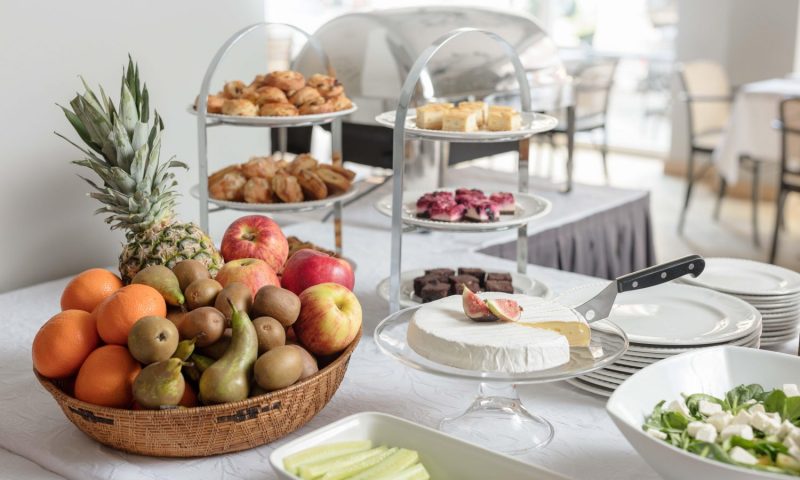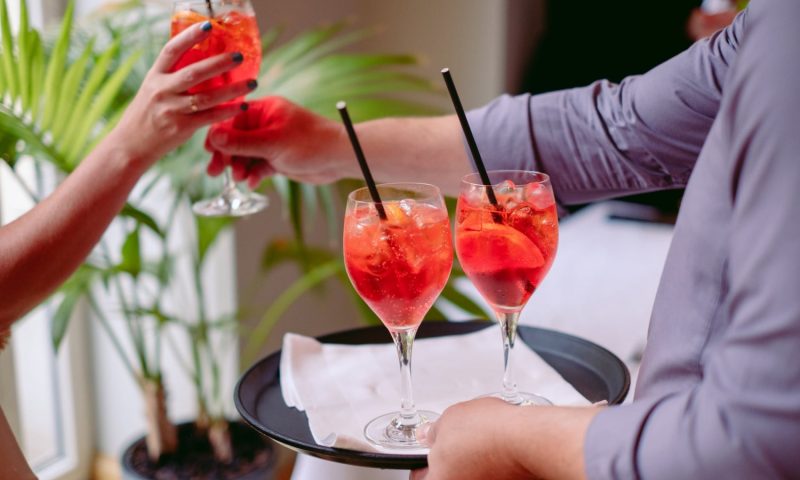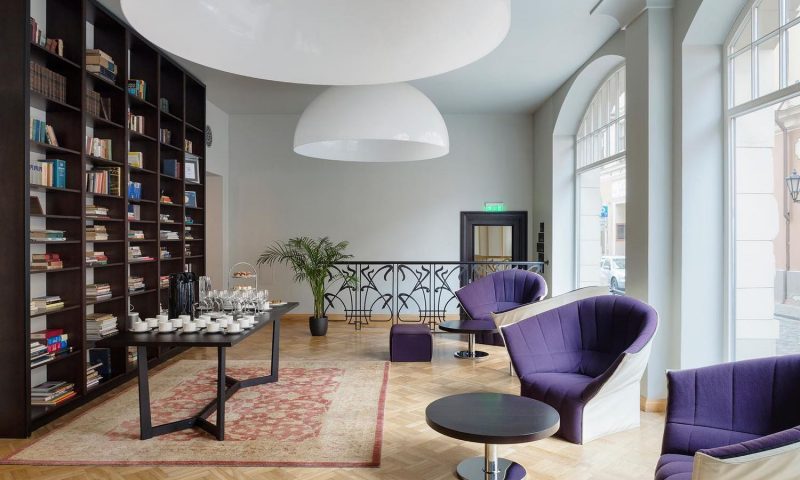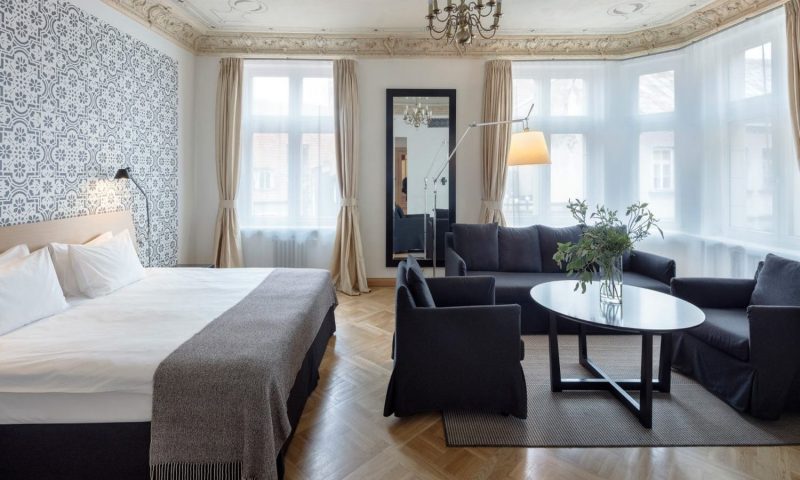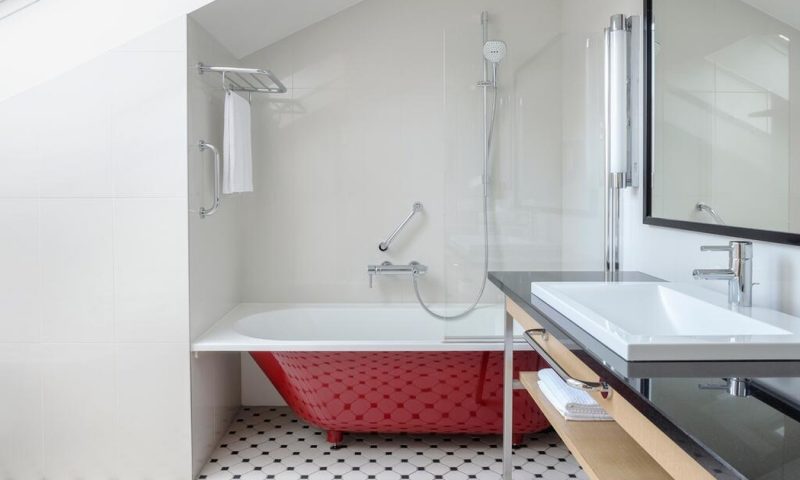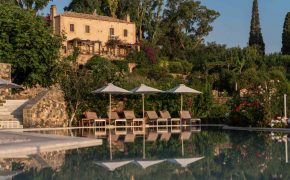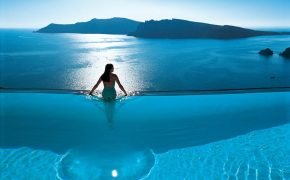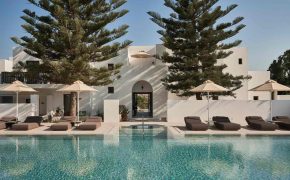The boutique apartment Hotel & Restaurant Neiburgs is a family Art Nouveau era property located in the heart of Riga’s Old Town (Vecrīga), next to the Dom Cathedral.
It is only a five- to ten-minute walk to the Latvian National Opera and Ballet, the best concert halls and museums. The views from the hotel’s windows are of the Old Town and the left bank of the Daugava River.
The hotel was constructed, combining careful attention to the architectural heritage, with care for every guest’s satisfaction. Where possible the original details of the building were preserved: wood parquets, adornments of walls and ceiling, widows, banisters and doors. Ornaments found in the original interiors were used in the renovation.
The historical elements are supplemented by carefully selected designer furniture and interior objects – the unique Moooi Dear Ingo ceiling lamps in the restaurant; the impressive Zava Ociu ceiling lamps, Ligne Roset armchairs and restored Thonet furniture in the library, Artemide lamps in the apartments and public space, etc.
Works by the well-known Latvian painter and sculptor Kristiāna Dimitere hang in the restaurant, whereas the apartments and conference rooms feature original graphics by Katrina Neiburga, a representative of the Neiburgs family who is a video and installation artist, set designer and film director of international renown.
The apartments are airy and light. All have built-in kitchens with an electric range, microwave, and an electric kettle. The suites feature two flat-screen televisions – one in the bedroom, the other in the living room. The well-appointed bathrooms have heated floors.
Natural light and lots of space, all modern conveniences and a personal approach allow our guests to fully enjoy each moment they spend at our hotel.
THE RECONSTRUCTION
After the Second World War and the nationalization of the Neiburgs family properties, this rental residential building was completely transformed. A “business hotel” (numbered rooms) for Soviet functionaries from other parts of Latvia was installed on the third floor.
The remaining apartments were changed into communal flats. In 13 original apartments 22 families were housed and, for this purpose, the original layout of the building was completely destroyed: rooms were divided by new partitions, some door openings were closed in while others installed, etc.
On the ground floor, a spacious beer restaurant Pie Kristapa opened, which became a typical example of socialist restaurant culture. Despite the fact that it, not unlike other Soviet restaurants, was far from crowded, entry was guaranteed either by paying off the doorman or one’s rank in the Soviet nomenklatura.
The building was immortalized not only in books dedicated to the architecture and cultural monuments of Riga but also in Soviet movies, for it seemed to match ideas of what a Western capitalist environment should look like; it was used as a backdrop for scenes taking place in many different Western European cities.
The late 1980s brought change to the Soviet Union. The restaurant Pie Kristapa became a place where well-known promoters of free entrepreneurship and national awakening often gathered.
After Latvia’s sovereignty was restored, the ownership rights that had existed before the Second World War were also restored and developer Ludvigs Neiburgs’s heirs could reclaim the properties that were taken away from them.
With the ties between the heirs living in Latvia and in exile strengthening, the idea was born to install a hotel and restaurant in the building 100 years after it had been constructed.
At the very beginning, the owners had a clear idea of what the new hotel should look like: with brightly-lit, spacious rooms where the historical heritage and feeling for art nouveau combine with modern design and conveniences to create a sense of privacy, cosiness and peace.
The hotel was designed by the architect Artūrs Lapiņš. Developing the sketches benefited from the involvement of a descendant of Ludvigs Neiburgs, the Australian-based architect Andrejs Andersons. The interior design was developed by the architect Iveta Cibule.
THE NEIBURGS FAMILY
The hotel building preserves not only the memories of the Neiburgs family but also of the consolidation of the Latvian nation and birth of an independent Latvian state.
In the second half of the 19th century, after abolishing serfdom in the province of tsarist Russia that later became Latvia, there was a vigorous development of cities as they saw an influx of people from the countryside.
Education was now accessible also to country children and young people. New factories and dwelling houses were built, the new entrepreneurs established well-to-do families. This was the time when Ludvigs Neiburgs (1871-1948) also came to Riga with his mother – they arrived in a boat used for transporting hay.
Having learnt the bricklayer’s trade, he became one of the most prominent city developers and one of the first Latvian entrepreneurs. He also oversaw the building of the present-day hotel Neiburgs, designed by the well-known Baltic German architect Wilhelm Bokslaff (1858-1945).
After the First World War and revolution in Russia, as new nation states emerged in Europe, Latvians, Lithuanians and Estonians who lived in the western part of the Russian Empire also gained independence and established their own national states.
Ludvigs Neiburgs was actively involved in building the new Latvian state also in the literal sense of the word: his company constructed important public buildings and also helped to fulfil the dreams of private individuals.
The building of the Ministry of Finance in the Old Town, the Tower of Three Stars at the Riga Castle, the Brethren Cemetery Monument, Pauls Stradiņš Clinical University Hospital in Pārdaugava, sugar factories in Krustpils, Jelgava and Liepāja as well as the bridge over the Gauja in Sigulda, technologically unique for its time – these are only some examples of Neiburgs’s work.
The Second World War and loss of Latvia’s independence disrupted this work. Ludvigs Neiburgs died in relative poverty at his country house in 1948. Of his five children, one spent years in a Gulag camp in Siberia, one was deported and two emigrated. His wife Alma Neiburgs spent years not knowing the fate of her children.
Ludvigs’s properties were nationalized. Many among the Latvian middle class and intelligentsia were either deported or had emigrated and the authorities turned their abandoned homes into communal flats often housing five or six families, which used the same kitchen and bathroom.
Ludvigs Neiburgs’s properties were restored to his heirs only in the 1990s, after Latvia regained independence. The company Neiburgu Īpašumi was established to manage them. Almost 100 years after the building in the Old Town was completed, Neiburgs’s heirs decided to transform it into a hotel bearing the name of its builder.
ART NOUVEAU HERITAGE
Designed by the Baltic German architect Wilhelm Bokslaff (1858—1945), the building with the ornate, turn-of-the-20th century façade was not constructed to house a hotel.
It was a typical early 20th century dwelling house with small shops on the ground floor selling all kinds of everyday goods, from fruit and vegetables to kerosene. On the upper floors, there were rental flats. There are over 800 Art nouveau buildings in Riga, but the Neiburgs building is one of the oldest in the centre of the Old Town.
Even though 1904 is officially considered the starting point of Riga’s art nouveau architecture, Ludvigs Neiburgs constructed his building a year earlier, reflecting in the façade the same eclectic art nouveau or Jugendstil tradition that is found in the later examples of this style mostly imported from Germany.
In the subsequent years, leading up to the breakout of the First World War, this style was gradually replaced by the ‘perpendicular’ art nouveau or Warenhausstil, and then by the national romantic art nouveau closely related to the style that was popular in contemporary Finland.
TWO-STOREY SUITES
A spacious living room with a built-in kitchen; bedroom and a well-appointed bathroom on the second floor. Some of the suites can be connected to the adjoining one-storey room for a comfortable family dwelling. Designer furniture and lamps, parquet floors, curtains of natural silk.
SENIOR SUITES
A luxurious and spacious living room with lots of light; a kitchenette, bedroom and a well-appointed bathroom. A view of Riga’s Old Town. Some suites have a balcony. Designer furniture and lamps, parquet floors, natural silk curtains; historical details in some suites.
STUDIO DELUXE
A luxurious and spacious combined living and sleeping space with lots of light and a well-appointed bathroom. A kitchenette with a dining table in a separate recess. Designer furniture and lamps, parquet floor, natural silk curtains, historical detailing in some rooms.
STUDIO APARTMENTS
Combined living room and bedroom with a built-in kitchen and a spacious bathroom. Armchairs or couches, a comfortable workspace. Designer furniture or lamps, parquet floor, natural silk curtains, historical detailing in some rooms.
THE RESTAURANT
The success of Restaurant Neiburgs is based on a blend of historical and stylish elements both in the interior and in the menu. The interior is airy and light; the food combines the traditional with the contemporary; and the ambience is enhanced by music, which is quiet enough not to prevent one from hearing one’s table companion.
The restaurant menu is defined by flavours popular in Latvia and use of seasonal locally sourced ingredients from Riga Central Market and Latvian farmers, as well as carefully selected imported products. This way, local traditions meet influences of cuisines from around the world.
Neiburgs Restaurant supports the highest standards of animal welfare and therefore never uses battery hen eggs in its dishes. Through windows that once were display windows of ground floor shops, restaurant guests can watch the life of the Old Town as it passes by.
Works by the well-known Latvian painter Andris Eglītis are on display at the restaurant. Lighting is provided by the unique MOOOI Dear Ingo ceiling lamps. In summer, guests are welcome to use the open-air terrace of the restaurant.
FITNESS & RELAXATION
Visitors and locals alike are welcome to spend some tranquil relaxation time at the spa salon of HOTEL NEIBURGS. You can enjoy our sauna, steam bath and rainshower and order a glass of freshly squeezed juice from our restaurant.
Our partner, one of the most popular and sophisticated professional spa companies in Riga, offers a choice of treatments exclusively selected to meet our requirements, as well as some special rituals that will help dispel any travel tension.
LIBRARY & BUSINESS CENTER
Our library offers books and magazines in several languages. Relax in one of the comfortable Ligne Roset armchairs to read a book or enjoy a cup of tea or glass of wine. This is also the ideal spot for small gatherings – receptions or press conferences.
At the business centre of Hotel Neiburgs, you are welcome to use Apple iMac computers with a fast Internet connection. The Business Centre is also a space suitable for small conferences.
CONFERENCES
Seminar, conference, celebratory dinner, reception or a party with friends – we will provide the appropriate space and everything you might need for your special event to be a success.
ART NOUVEAU IN RIGA
About one third of the historical buildings in Riga are in the art nouveau style. Most of them originated in the decade from 1904 to the beginning of the First World War. In this relatively brief period, three visually Distinct kinds of art nouveau took hold in Riga.
The oldest is the eclectic or decorative, followed by the geometric or perpendicular and, finally, the national romantic art nouveau. Most of the art nouveau buildings are concentrated in the so-called ‘quiet centre’ of Riga, on Elizabetes and Alberta streets.
LATVIAN NATIONAL SYMPHONY ORCHESTRA
A cornerstone of Latvian culture, the Latvian NAtional Symphony Orchestra is based in the heart of Riga Old Town – at the historic Great Guild, just less than a five-minute walk from the hotel. The orchestra regularly offers high quality symphonic programmes to locals and visitors alike, including both academic masterpieces and contemporary opuses.
Every season, several chamber music concerts are given along with performances for children and youngsters, while in summer the orchestra travels to regional concert halls to delight audiences at the LNSO Summer Festival.
THE LATVIAN NATIONAL OPERA
The Latvian National Opera & Ballet is located only an eight-minute walk from the hotel. During the season, over 200 performances take place – both new productions and those that have already won public acclaim – with the participation of the most outstanding local and foreign opera and ballet stars. The Riga Opera Festival, which is held in summer, has been marked in many an opera fan’s calendar.
NEW RIGA THEATRE
Under the internationally acclaimed director Alvis Hermanis, Jaunais Rigas Teatris has expanded audience’s ideas about theatre and its vocabulary both in Latvia and abroad.
The artistic originality of the performances is always imbued with powerful humanism and the public shows its appreciation by buying up tickets many months in advance. The theatre is about a twenty minute walk FROM THE HOTEL.
ĀGENSKALNS MARKET
Open since 1898, Āgenskalns Market is the largest and oldest market in the neighborhood and has the status of a national cultural monument. From 2018 to 2022 the historical pavilion of the market had a renovation and it reopened in May 2022. Now everyone is invited to view the impressive changes after the renovation.
On the first floor of the renewed pavilion it is possible to buy local products from farmers, home producers and traders. On the second floor are located bars and cafes, such as “VEST” bar, “Marmelāde” and “Vīnkalni” pizza, “Ausmena” kebab and others.
Āgenskalns Market is an inclusive, versatile and environmentally friendly public space where cultural, educational and various other events such as art festivals, concerts and theatrical performances take place in collaboration with neighborhood citizens and organizations.
THE ZUZEUM ART CENTRE
The Zuzeum Art Centre is home to the Zuzāns Art Collection, the largest private collection of Latvian art in the world. The Zuzeum building, constructed in 1910 as a cork factory and designed by the architect and engineer Edmund von Trompowsky, is a contemporary of many of the artworks represented in the collection and several generations of Latvian artists.
It witnessed the time when the first modernists were active in Riga and the first art schools were opened in the city. Following the renovation of the building in the first half of 2020, Zuzeum now invites everybody over for an art experience in its two exhibition galleries with the total area of 1100 square metres, a sculpture garden, café and on its rooftop terrace.
The exhibition programme of the art centre is complemented by tours, talks, concerts, film screenings and DJ nights.
ĶĪPSALA WOODEN ARHITECTURE
If you head out of the city centre, you will find whole quarters of Wooden Architecture that have survived even from the late 19th century. The buildings on Ķīpsala Island are a fine example of this. But try other places too – Āgenskalns, Maskačka. Or walk around just outside the UNESCO heritage city centre – you may find some truly unexpected treasures!
